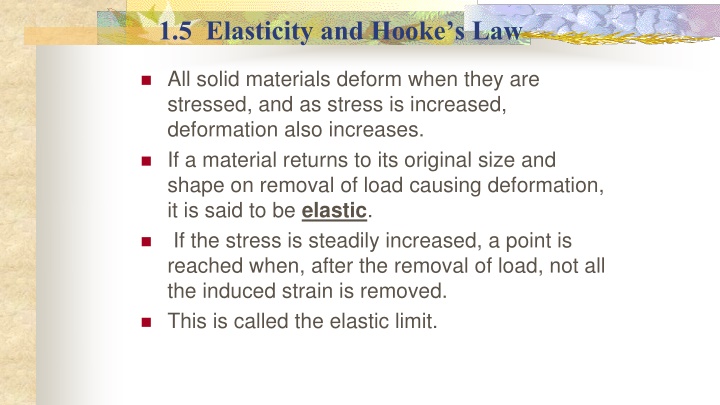
Elasticity, Hookes Law, and Stress-Strain Relations
Explore the concepts of elasticity, Hookes Law, stress-strain relations, and factors of safety in materials science. Learn about deformation, modulus of elasticity, and the importance of working stress limits. Discover the significance of factor of safety in engineering design.
Download Presentation

Please find below an Image/Link to download the presentation.
The content on the website is provided AS IS for your information and personal use only. It may not be sold, licensed, or shared on other websites without obtaining consent from the author. If you encounter any issues during the download, it is possible that the publisher has removed the file from their server.
You are allowed to download the files provided on this website for personal or commercial use, subject to the condition that they are used lawfully. All files are the property of their respective owners.
The content on the website is provided AS IS for your information and personal use only. It may not be sold, licensed, or shared on other websites without obtaining consent from the author.
E N D
Presentation Transcript
1.5 Elasticity and Hookes Law All solid materials deform when they are stressed, and as stress is increased, deformation also increases. If a material returns to its original size and shape on removal of load causing deformation, it is said to be elastic. If the stress is steadily increased, a point is reached when, after the removal of load, not all the induced strain is removed. This is called the elastic limit.
Hookes Law States that providing the limit of proportionality of a material is not exceeded, the stress is directly proportional to the strain produced. If a graph of stress and strain is plotted as load is gradually applied, the first portion of the graph will be a straight line. The slope of this line is the constant of proportionality called modulus of Elasticity, E or Young s Modulus. It is a measure of the stiffness of a material.
Hookes Law Direct strain= Modulus of Elasticity, E = Direct stress Shear strain= Also: For Shear stress: Modulus of rigidity or shear modulus, G = Shear stress Also: stress, Volumetric strain, within the elastic range / v is proportional to hydrostatic = K i.e. : called bulk modulus.
Equation For Extension From the above equations: F L A dl F A dl L / / = = = E F L A E = dl This equation for extension is very important
Extension For Bar of Varying Cross Section For a bar of varying cross section: P A1 A2 A3 P L1 L2 L3 L NM O QP F E L A L A L A = + + 1 2 3 dl 1 2 3
Factor of Safety The load which any member of a machine carries is called working load, and stress produced by this load is the working stress. Obviously, the working stress must be less than the yield stress, tensile strength or the ultimate stress. This working stress permissible stress or the allowable stress or the design stress. is also called the
Factor of Safety Contd. Some reasons for factor of safety include the inexactness or inaccuracies in the estimation of stresses and the non-uniformity of some materials. Factor of safety = Ultimateor yield stress Design or working stress Ultimate stress is used for materials e.g. Note: concrete which do not have a well-defined yield point, or brittle materials which behave in a linear manner up to failure. Yield stress is used for other materials e.g. steel with well defined yield stress.
1.7 Practical Class Details Each classes: one on : Stress/strain characteristics and Hardness and impact tests. (i) The stress/strain characteristics practical will involve the measurement of the characteristics for four metals, copper, aluminium, steel and brass using a tensometer. Student will have two practical
Practical Class Details Contd. The test will be done up to fracture of the metals. This test will also involve the accurate measurement of the modulus of elasticity for one metal. There is the incorporation of an extensometer for accurate measurement of very small extensions to produce an accurate stress-strain graphs. The test will be done up to elastic limit.
